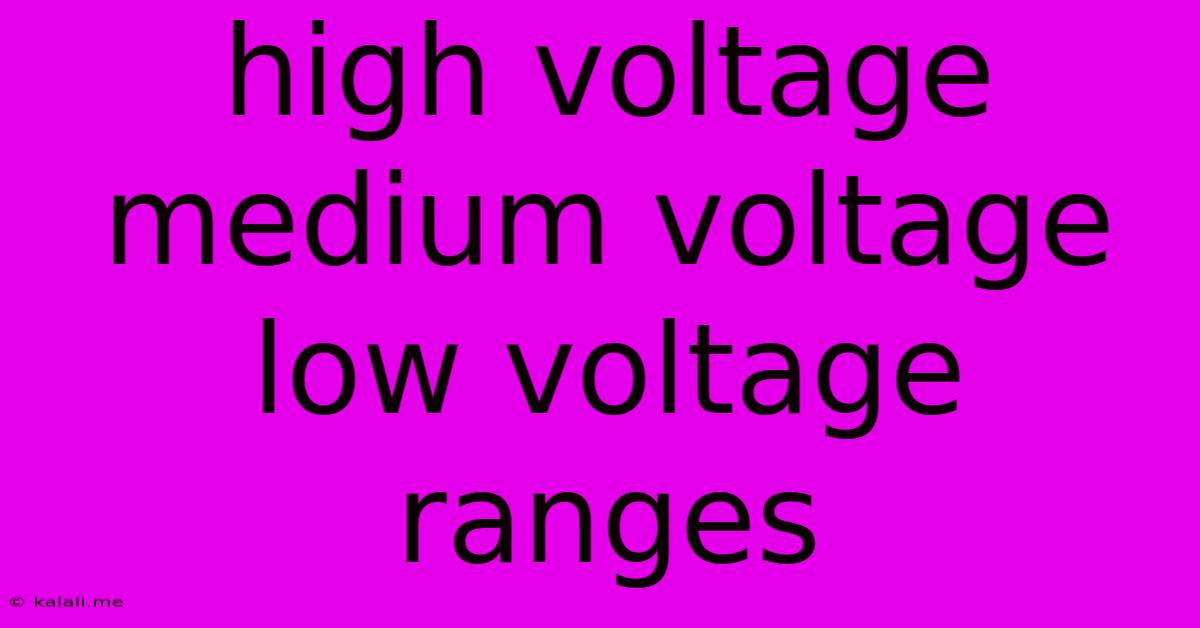High Voltage Medium Voltage Low Voltage Ranges
Kalali
Jun 13, 2025 · 3 min read

Table of Contents
Understanding High, Medium, and Low Voltage Ranges: A Comprehensive Guide
Meta Description: This guide provides a clear explanation of high, medium, and low voltage ranges, their applications, safety precautions, and the differences between them. Learn about the voltage levels, typical uses, and potential dangers associated with each category.
Voltage is a fundamental concept in electrical engineering and plays a crucial role in various applications, from powering our homes to driving industrial machinery. Understanding the different voltage ranges – high, medium, and low – is essential for anyone working with electricity, ensuring safety and efficient system design. This article provides a comprehensive overview of each voltage category, highlighting their typical applications and safety considerations.
What is Voltage?
Before delving into the specific voltage ranges, let's briefly define voltage. Voltage, also known as electromotive force (EMF), is the electrical potential difference between two points. It represents the "push" that drives electric current through a conductor. The higher the voltage, the greater the potential energy and the stronger the push. This push is measured in volts (V).
High Voltage (HV) Range
High voltage is generally considered to be anything above 1000 volts (1 kV). However, the exact threshold can vary depending on the context and specific standards. High voltage systems are commonly used in:
- Power Transmission and Distribution: High-voltage transmission lines carry electricity over long distances, minimizing energy loss during transmission. These lines often operate at voltages exceeding 100 kV and even reaching hundreds of kV.
- Industrial Applications: High-voltage systems power large industrial equipment, such as electric motors, furnaces, and welding machines.
- Particle Accelerators: High-voltage systems are crucial for accelerating charged particles in research facilities like CERN.
- X-ray Machines: Medical X-ray machines utilize high voltage to generate the X-rays needed for diagnostic imaging.
Safety Precautions: Working with high voltage is extremely dangerous and requires specialized training, equipment, and safety protocols. Improper handling can lead to severe electric shock, burns, and even death. Always follow established safety procedures and use appropriate protective gear, such as insulated tools and protective clothing.
Medium Voltage (MV) Range
Medium voltage typically falls within the range of 1 kV to 100 kV. This voltage range finds applications in:
- Sub-transmission and Distribution Networks: Medium-voltage systems distribute electricity from substations to smaller distribution networks supplying commercial and industrial areas.
- Large Industrial Facilities: Many industrial facilities utilize medium-voltage systems to power large motors, transformers, and other equipment.
- Commercial Buildings: Some large commercial buildings may utilize medium voltage for efficient power distribution.
Safety Considerations: While the risks associated with medium voltage are lower than those of high voltage, it still poses a significant hazard. Proper training, safety procedures, and personal protective equipment are essential to mitigate the risks.
Low Voltage (LV) Range
Low voltage is generally considered to be anything below 1000 volts (1 kV). This is the most common voltage range encountered in everyday life, including:
- Residential Power Supply: Homes and apartments are typically powered by low-voltage electricity, usually around 120V or 240V depending on the region.
- Electronics and Appliances: Most electronic devices, appliances, and lighting fixtures operate on low-voltage electricity.
- Battery Systems: Batteries used in vehicles and portable devices generate low voltage.
Safety Precautions: Although low voltage is generally considered safer than high or medium voltage, it can still cause harm. While the risk of fatal electric shock is lower, contact can still result in burns or other injuries. Proper handling of electrical equipment and adherence to safety guidelines are always necessary.
Key Differences and Summary
The primary differences between high, medium, and low voltage ranges lie in their voltage levels, applications, and associated safety risks. High voltage systems are used for long-distance power transmission and high-power industrial applications, presenting the highest risk of electrical hazards. Medium voltage serves intermediate distribution networks and larger facilities, while low voltage is commonly found in homes, offices, and electronic devices, with the lowest risk but still requiring careful handling. Understanding these distinctions is crucial for ensuring safe and efficient operation of electrical systems.
Latest Posts
Latest Posts
-
Second Most Abundant Element In Earths Crust
Jun 14, 2025
-
What Is The Density Of The Mantle
Jun 14, 2025
-
Which Statement About Bacteria Is Incorrect
Jun 14, 2025
-
First Psychology Laboratory Was Established By
Jun 14, 2025
-
Which Of The Following Is A Type Of Input Device
Jun 14, 2025
Related Post
Thank you for visiting our website which covers about High Voltage Medium Voltage Low Voltage Ranges . We hope the information provided has been useful to you. Feel free to contact us if you have any questions or need further assistance. See you next time and don't miss to bookmark.